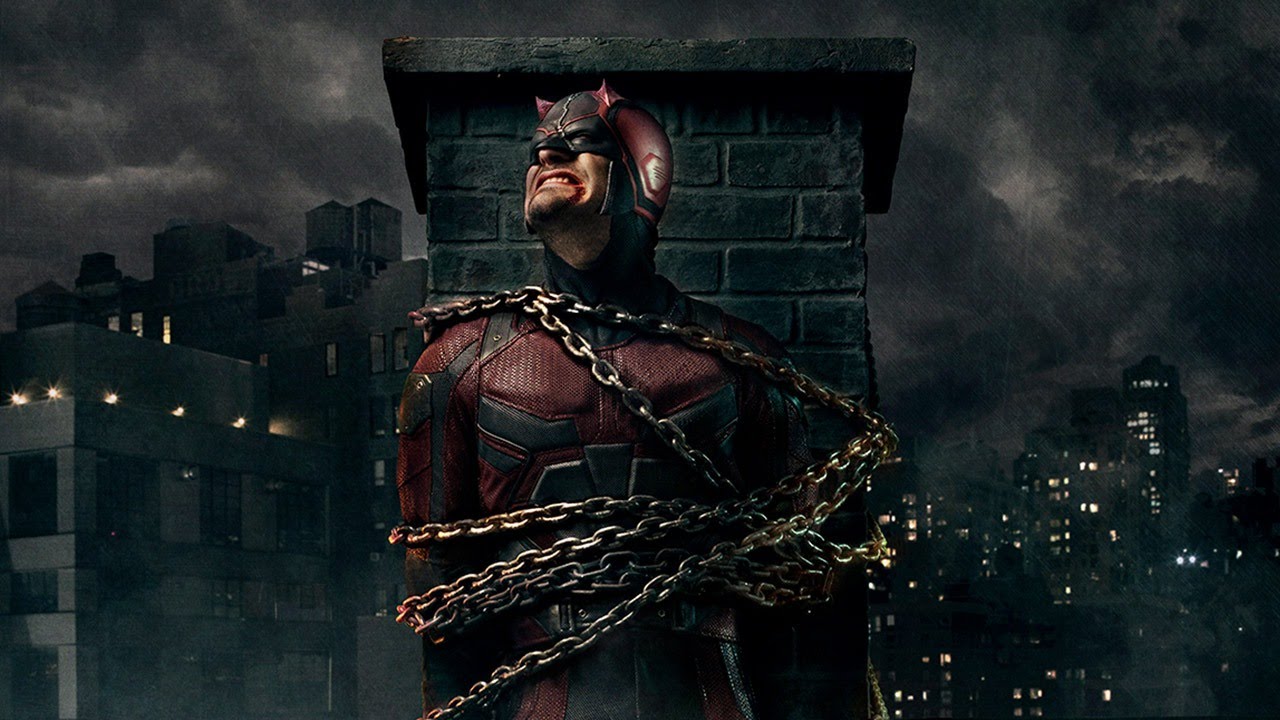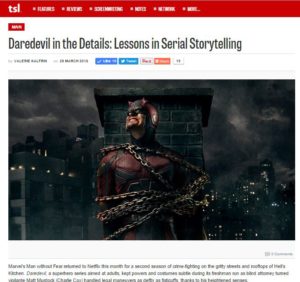
Charlie Cox in “Daredevil” / Netflix poster
By Valerie Kalfrin
The Script Lab, March 28, 2016
Marvel’s Man without Fear returned to Netflix this month for a second season of crime-fighting on the gritty streets and rooftops of Hell’s Kitchen. Daredevil, a superhero series aimed at adults, kept powers and costumes subtle during its freshman run as blind attorney turned vigilante Matt Murdock (Charlie Cox) handled legal maneuvers as deftly as fisticuffs, thanks to his heightened senses.
Matt’s father was a boxer, so it’s appropriate that the initial season had the rhythms of a boxing match. The show burst out of its corner with a palpable energy, danced around a bit in the middle, then found its footing to build up to a knockout.
Good stories depend on pacing. We might love certain characters or quote particular lines, but what keeps us watching or reading is that steady momentum, that forward drive.
Screenwriters who outline story beats for a film in their sleep still can stumble when writing a series. Series are deceptive because of their length. “It’s like doing a 13-hour film,” said Vincent D’Onofrio, who relished the chance to explore different shades of Daredevil’s nemesis Wilson Fisk. “So, I think that lends itself to being able to be much more specific and take your time in telling this long story.”
Sure, a series has a longer running time, and actors dig the chance to dive deep—but don’t kid yourself. If you take too much time to unspool your story, your audience will wander off.
With Daredevil’s season two in our queue, we thought we’d highlight five ways the show kept pace during its previous go-round. (Mild spoilers follow.) Here’s hoping this helps hone your storytelling senses.
Knowing the end point
Deciding where to end each season—and where you’d like to end up after several—is crucial. More than one critic has lamented a series that starts promisingly only to meander through too many twists and no clear resolution.
Daredevil hooked us in season one by giving us Matt in the middle of his origin story. He ventures out at night in the first episode as a masked man in black to battle human traffickers. The series showed how a chemical spill blinded Matt as a boy but enhanced his hearing and perception; how his father died; and how a brusque blind man with similar skills (Scott Glenn) mentored Matt in martial arts. Yet the goal was Matt comfortably becoming Daredevil—complete with red body armor and a nickname from the press—by the season finale.
Matt needed a worthy foe behind the scenes, so the writers laid out a parallel origin story for Fisk, showing how this wealthy, violent man turned into the Kingpin. Fisk didn’t appear until the third episode, already partway through his evolution. The two crossing each other’s paths fueled their transformations, culminating in a satisfying showdown.
Knowing the characters
Daredevil built a net of characters whose secrets and motivations influenced one another in dramatic ways. Matt has strong convictions but not super strength. “He’s not invulnerable,” season one showrunner Steven DeKnight has said, “In every aspect, he’s a man that’s just pushed himself to the limits.”
Matt’s strong Catholic faith and his moonlighting make Daredevil perhaps the most conflicted hero in the Marvel universe. Nurse Claire Temple (Rosario Dawson), who patches up Matt’s injuries, was drawn to Matt yet couldn’t approve of his methods. Matt’s best pal and law partner Foggy Nelson (Elden Henson) wondered how Matt’s tactics differ from the criminals they defend. Then there’s Karen (Deborah Ann Woll), Matt and Foggy’s paralegal, who kept the two in the dark about her meetings with a reporter (Vondie Curtis-Hall) piecing together Fisk’s criminal network.
Cox said he expects Matt’s morals to become more complicated this season as two characters “force him to look at himself and look at his actions in a way no one else has done in the past.” Electra (Elodie Yung), Matt’s old girlfriend, is now an assassin. Frank Castle, aka The Punisher (Jon Bernthal), takes Daredevil’s street justice farther, firing barrages of bullets at his targets, never mind bystanders.
Knowing the scope
Unlike the grand scale of The Avengers, Daredevil focuses on New York City’s Hell’s Kitchen, known for decades as a rough neighborhood for the poor and working-class. It stretches north from about 34th Street to 59th Street and from Eighth Avenue to the Hudson River—a slice of the Big Apple, not an entire buffet. Knowing the size of your sandbox allows you to focus on story choices that fit snugly within that particular world.
As Jeph Loeb, head of Marvel television, has said, Hell’s Kitchen is a character, too: “a place of battered brick, and wet streets, and steam coming up, and that amber hue that comes off the taxicabs at night. That’s the New York that Daredevil lives in.”
Knowing the tone
Daredevil is a show of darkness, befitting both Matt’s nighttime activities and the morally gray area where he operates. Matt lives in a low-rent apartment bathed in neon lights, but there are few bright spots beyond the warm rapport among Matt, Foggy, and Karen and the chemistry between Matt and Claire. A lot of the action takes place at night, in dim alleys or hallways, and it’s brutally violent.
And although Foggy cracks jokes, Matt and Daredevil never do at the people he’s trying to save from evil. He’s the sensitive center of what Esquire called “neo-noir attitude” painted “in shadows and blood.”
Knowing the theme
The richest stories tie every character and scene to an overarching theme. The conflict of doing the wrong thing for the right reasons is crucial to Daredevil, a hero who thinks he’s on the side of the angels but isn’t afraid to get his hands dirty. As Matt’s body and his conscience take a beating, tension unfolds with those privy to his secret.
Matt’s drawn a fine line against killing anyone, but he doesn’t flinch dropping a guy off a roof or hesitate from beating people to a pulp. Our fascination lies in wondering how far he’ll go, and what’s stopping him from going too far.
Not much, at least in the Punisher’s view. As Bernthal notes in the trailer: “You know you’re one bad day away from being me.”
From http://thescriptlab.com/features/main/3478-daredevil-in-the-details-lessons-in-serial-storytelling#

